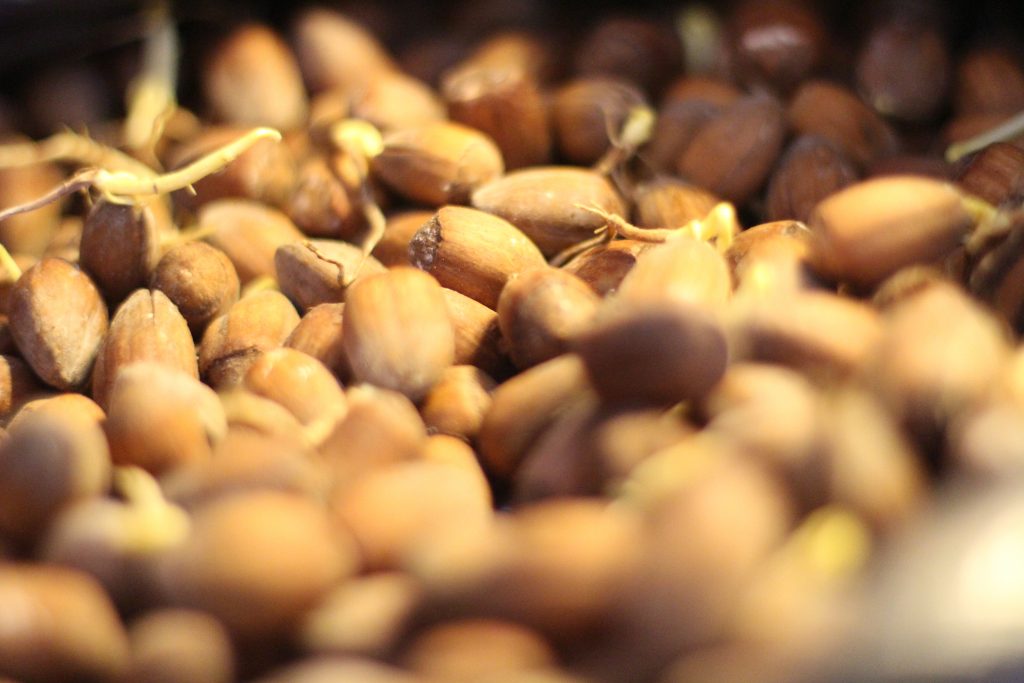ABOUT US
Our family has been living and working at Allens Farm for over 100 years, and we currently mainly farm what we believe to be the largest number of Cobnut trees in the UK. All 2,700 of our Cobnut trees are now in full production thanks to the efforts of our neighbour, the crop is looking good and we look forward to the Cobnuts maturing towards the end of August.
A BRIEF HISTORY OF THE COBNUT
John Evelyn 1664
“They crop more plentifully if the ground be somewhat moist, dankish and mossie, as in the fresher bottoms, and the sides of hills, hoults, and in the hedgerows.“
A Kentish cobnut is a type of hazelnut. Most of the hazelnuts grown in Britain are of the named variety Kentish Cob, which was introduced in the early 19th century, and more Cobnuts are grown in Kent than anywhere else. However, growers are now beginning to plant other varieties too, and there are commercial producers in many other countries. Whilst the different varieties of cobnut all have a similar taste, each variation has different properties that make them unique in terms of storing, cooking and growing (scroll down to find out more about the different types of cobnuts).
Man has enjoyed wild hazelnuts and cobnuts from time immemorial, and cultivated hazels, sometimes known as filberts, have been grown in Britain since at least the 16th century. The word Cob originates from the Middle English Cobbe, referring to a ’round object’, and filbert derives from the German Vollbart which refers to a ‘full beard’ that the husk of a hazelnut resembles. The world filbert is therefore often used interchangeably with the world hazelnut, however more recently the word has been more commonly used for commercially cultivated crops of hazelnuts.
Children played an early version of “conkers” with hazelnuts; the game was called cobnut, and the winning nut the cob.
Cobnuts are marketed fresh, not dried like most other nuts such as walnuts and almonds. Consequently they can usually only be bought when in season, typically from about the middle of August through to October, although stored nuts may be kept until Christmas. At the beginning of the season the husks are green and the kernels particularly juicy. Nuts harvested later on have brown shells and husks, and the full flavour of the kernel has developed.
Yotam Ottolenghi
“Cobnuts have a fresher flavour than any other nut I know of and go very well with autumnal fruit and light cheeses.”
Cobnuts were popular with mariners, as they kept fresh for months, and the Victorians were devoted to them and bred many new kinds. In 1913, plantations extended to over 7,000 acres, most of the orchards or “plats” being in Kent. Stored nuts were available from London wholesalers for most of the year, and fetched high prices. However, today, 200 – 250 acres of old plats survive, but new orchards are once again being planted, of Kentish Cob as well as other hazelnut varieties. Fortunately cobnuts are not prone to pests and diseases, and there is rarely any commercial need for crop protectants or fertilisers; many growers use none at all. The crop is picked by hand.
Types of Cobnut
Kentish Cob: A reliable crop, relatively hardy, with excellent flavour; also available as Longue d’Espagne; pollinated by Gunslebert, Cosford and Merveille de Bollwiller.
Gunslebert: hardy, vigorous and very productive producing medium-sized nuts: pollinated by Cosford and Kentish Cob.
Merveille de Bollwiller; Also called Hall’s Giant; a hardy, vigorous and productive variety with large nuts; pollinated by Cosford, Butler, Ennis and Kentish Cob.
Butler: A large mid to late season nut, hardy, vigorous and a heavy crop; a short-husked variety that de-husks freely when ripe; popular for modern commercial production; pollinated by Ennis, Merveille de Bollwiller.
Ennis; a very attractive large round nut with a superb flavour, but tendency to produce a significant proportion of blank nuts limits commercial value; pollinated by Butler, Merveille de Bollwiller.
Cosford: this is one of the best-flavoured varieties, with thin-shelled nuts, but it is not a heavy bearer; pollinated by Gunslebert, Merveille de Bollwiller, Kentish Cob.
(This information was provided by the Kentish Cobnuts Association)
Nutritional Value
Cobnut kernels typically contain 12% – 17% protein by dry weight, and about 10%- 15% fibre. They are very rich in vitamin E and in calcium, typically containing about 21mg and 141mg per 100g kernel (dry weight). They provide about 0.4mg and 0.55mg of vitamins B1 and B6 respectively per 100g dry weight.
The Season and Storing
The growing season is August – October, but the nuts will store for up to a year in a cool dark place, out of their husks. Like many fresh foods, cobnuts should ideally be kept in a fridge. Do not let them sweat. Loose husks should be removed, but it is not necessary to take off every husk. Remove the husks when they go brown and store the Kernels in a polythene bag in a cool place.
To rehydrate kernels, they should be placed in their shells, in a saucer of water overnight.
Sorting and Packaging

Our cobnut sorting process is extremely thorough, with nuts first being de-husked, and then hand-sorted to ensure that your nuts are of the highest standard. Our Cobnuts are dispatched in strong polypropylene bags, which protect the nuts in transit by Courier, ensuring the best quality possible.


